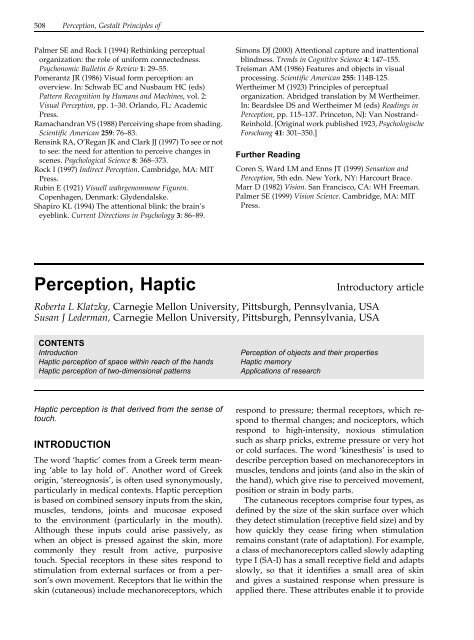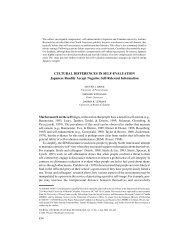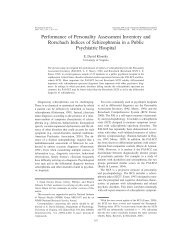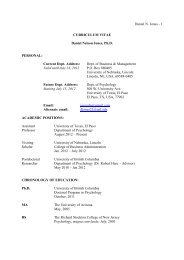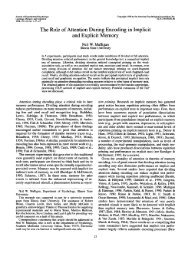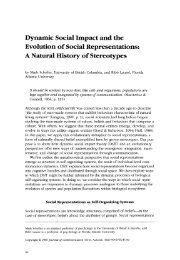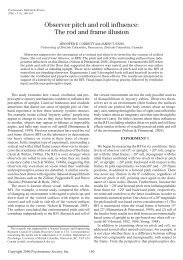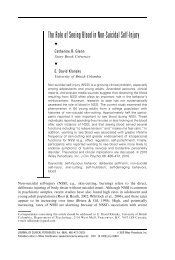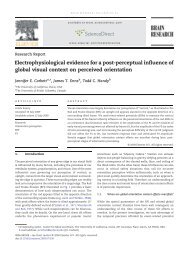Gestalt Grouping Principles - HomePage Server for UT Psychology
Gestalt Grouping Principles - HomePage Server for UT Psychology
Gestalt Grouping Principles - HomePage Server for UT Psychology
Create successful ePaper yourself
Turn your PDF publications into a flip-book with our unique Google optimized e-Paper software.
508 Perception, <strong>Gestalt</strong> <strong>Principles</strong> of<br />
Palmer SE and Rock I (1994) Rethinking perceptual<br />
organization: the role of uni<strong>for</strong>m connectedness.<br />
Psychonomic Bulletin & Review 1: 29±55.<br />
Pomerantz JR (1986) Visual <strong>for</strong>m perception: an<br />
overview. In: Schwab EC and Nusbaum HC (eds)<br />
Pattern Recognition by Humans and Machines, vol. 2:<br />
Visual Perception, pp. 1±30. Orlando, FL: Academic<br />
Press.<br />
Ramachandran VS (1988) Perceiving shape from shading.<br />
Scientific American 259: 76±83.<br />
Rensink RA, O'Regan JK and Clark JJ (1997) To see or not<br />
to see: the need <strong>for</strong> attention to perceive changes in<br />
scenes. Psychological Science 8: 368±373.<br />
Rock I (1997) Indirect Perception. Cambridge, MA: MIT<br />
Press.<br />
Rubin E (1921) Visuell wahrgenommene Figuren.<br />
Copenhagen, Denmark: Glydendalske.<br />
Shapiro KL (1994) The attentional blink: the brain's<br />
eyeblink. Current Directions in <strong>Psychology</strong> 3: 86±89.<br />
Simons DJ (2000) Attentional capture and inattentional<br />
blindness. Trends in Cognitive Science 4: 147±155.<br />
Treisman AM (1986) Features and objects in visual<br />
processing. Scientific American 255: 114B-125.<br />
Wertheimer M (1923) <strong>Principles</strong> of perceptual<br />
organization. Abridged translation by M Wertheimer.<br />
In: Beardslee DS and Wertheimer M (eds) Readings in<br />
Perception, pp. 115±137. Princeton, NJ: Van Nostrand-<br />
Reinhold. [Original work published 1923, Psychologische<br />
Forschung 41: 301±350.]<br />
Further Reading<br />
Coren S, Ward LM and Enns JT (1999) Sensation and<br />
Perception, 5th edn. New York, NY: Harcourt Brace.<br />
Marr D (1982) Vision. San Francisco, CA: WH Freeman.<br />
Palmer SE (1999) Vision Science. Cambridge, MA: MIT<br />
Press.<br />
Perception, Haptic<br />
Introductory article<br />
Roberta L Klatzky, Carnegie Mellon University, Pittsburgh, Pennsylvania, USA<br />
Susan J Lederman, Carnegie Mellon University, Pittsburgh, Pennsylvania, USA<br />
CONTENTS<br />
Introduction<br />
Haptic perception of space within reach of the hands<br />
Haptic perception of two-dimensional patterns<br />
Perception of objects and their properties<br />
Haptic memory<br />
Applications of research<br />
Haptic perception is that derived from the sense of<br />
touch.<br />
INTRODUCTION<br />
The word `haptic' comes from a Greek term meaning<br />
`able to lay hold of'. Another word of Greek<br />
origin, `stereognosis', is often used synonymously,<br />
particularly in medical contexts. Haptic perception<br />
is based on combined sensory inputs from the skin,<br />
muscles, tendons, joints and mucosae exposed<br />
to the environment (particularly in the mouth).<br />
Although these inputs could arise passively, as<br />
when an object is pressed against the skin, more<br />
commonly they result from active, purposive<br />
touch. Special receptors in these sites respond to<br />
stimulation from external surfaces or from a person's<br />
own movement. Receptors that lie within the<br />
skin (cutaneous) include mechanoreceptors, which<br />
respond to pressure; thermal receptors, which respond<br />
to thermal changes; and nociceptors, which<br />
respond to high-intensity, noxious stimulation<br />
such as sharp pricks, extreme pressure or very hot<br />
or cold surfaces. The word `kinesthesis' is used to<br />
describe perception based on mechanoreceptors in<br />
muscles, tendons and joints (and also in the skin of<br />
the hand), which give rise to perceived movement,<br />
position or strain in body parts.<br />
The cutaneous receptors comprise four types, as<br />
defined by the size of the skin surface over which<br />
they detect stimulation (receptive field size) and by<br />
how quickly they cease firing when stimulation<br />
remains constant (rate of adaptation). For example,<br />
a class of mechanoreceptors called slowly adapting<br />
type I (SA-I) has a small receptive field and adapts<br />
slowly, so that it identifies a small area of skin<br />
and gives a sustained response when pressure is<br />
applied there. These attributes enable it to provide


